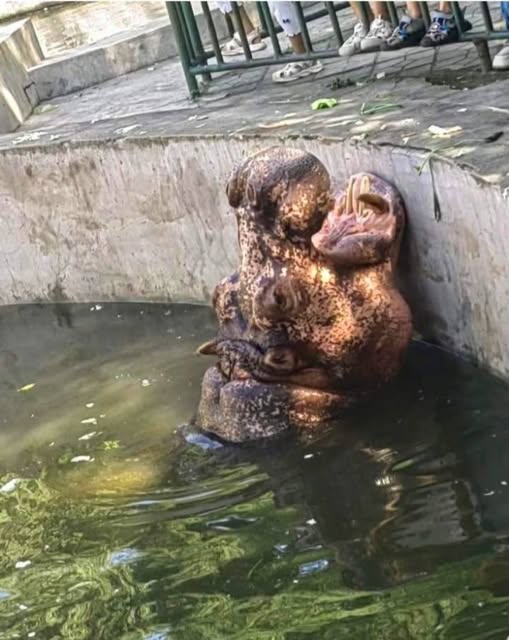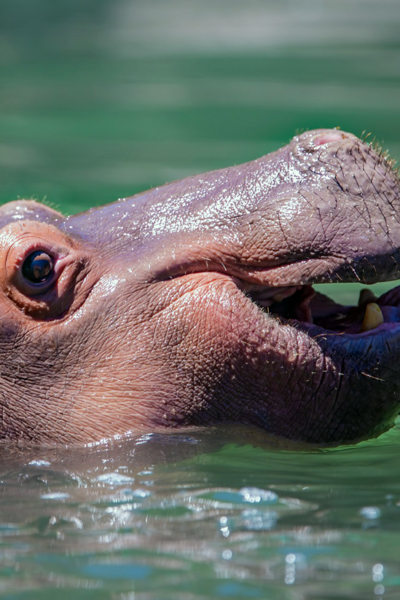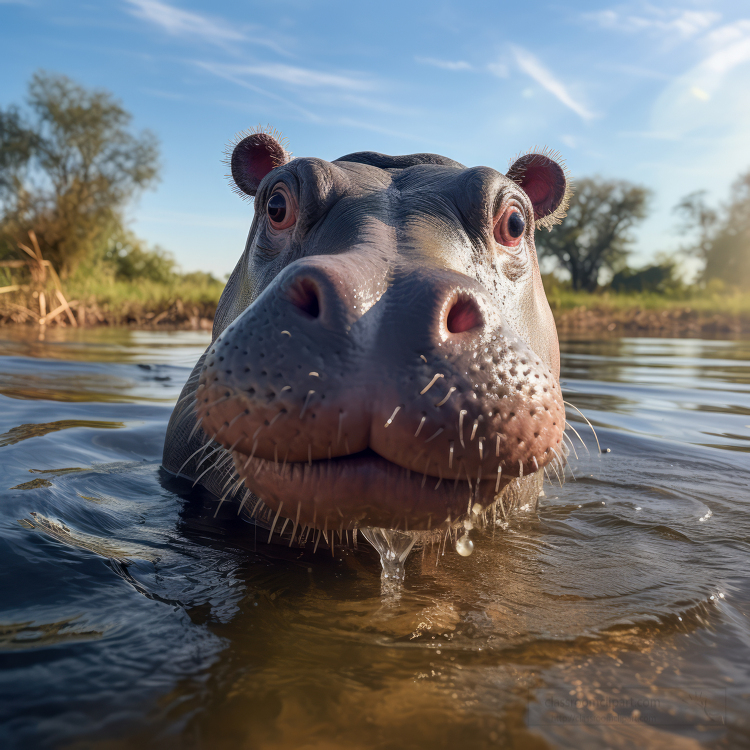At first glance, you may be convinced that you are staring at two extraterrestrial beings hiding underwater. The round, smooth shapes and eerie, almost featureless forms seem to merge with the water’s surface, suggesting that something out of this world is lurking beneath. However, what you’re actually observing isn’t aliens at all, but rather one of the river’s most iconic creatures – the hippopotamus.
The optical illusion is a fascinating example of how nature can sometimes appear as strange as anything imagined. The strange bulges and textured skin of the hippopotamus create the illusion of an alien, almost otherworldly form. Upon closer inspection, however, the truth becomes clear: these are not aliens, but a hippo, partially submerged in the water, resting in its natural habitat. This illusion is a perfect reminder that nature, with its remarkable diversity, can often play tricks on the mind.
The Hippo’s Mystique and the Optical Illusion

The illusion created by the submerged hippopotamus is captivating. When viewed from a distance, its massive body, especially its round head, appears eerily like the smooth, featureless surface of an alien. The water distorts the true shape, causing the skin to reflect light in a way that creates the illusion of smoothness and featurelessness. These visual cues deceive the brain, triggering the instinct to associate unfamiliar shapes with something extraterrestrial.
The texture of the hippo’s skin also contributes to the illusion. The thick, wrinkled, and mottled skin reflects the light in patterns that mimic the texture one might expect of an alien creature. The dark, shadowy areas of the water add to the mystery, further enhancing the illusion of an unknown life form peeking out from beneath the surface.
As the viewer’s gaze adjusts, the shape of the hippopotamus begins to emerge. Its wide mouth, agape and filled with distinct teeth, becomes visible. The nostrils and eyes of the hippo, though initially camouflaged by the water and shadows, become more apparent, dispelling the mystery. The initially strange, alien-like form slowly transitions back into a familiar and majestic animal: the hippopotamus.
A Closer Look at the Hippopotamus

Hippopotamuses, often simply called “hippos,” are large, mostly herbivorous mammals that live in rivers and lakes in sub-Saharan Africa. They are one of the largest land animals, with an average weight of around 4,000 pounds (1,800 kg). Despite their massive size, hippos are known for their surprisingly fast running speeds and aggressive nature, especially when they feel threatened.

A unique aspect of hippos is their love for water. They spend much of their day submerged in rivers or lakes to keep cool and protect their sensitive skin from the harsh African sun. Their bodies are well adapted to aquatic life, with eyes, ears, and nostrils located high on their heads, allowing them to see, hear, and breathe while mostly submerged.
Despite their somewhat comical appearance, hippos are highly territorial, especially when it comes to the water they inhabit. They can be very aggressive and are responsible for more human deaths in Africa than any other large animal. Yet, despite their dangerous reputation, they also play a vital role in their ecosystem, helping to maintain the health of aquatic environments by grazing on vegetation that would otherwise overrun the landscape.
The Importance of the Hippopotamus in Ecosystems

Hippos are often considered “keystone species” in their ecosystems. This means they have a disproportionately large effect on their environment relative to their size. By grazing on grasses near water, they help shape the landscape and create pathways for other animals. Their waste also plays an important role in maintaining the health of aquatic ecosystems. Hippo dung provides nutrients for fish and other organisms, supporting the food chain.
Additionally, hippos are often seen as a symbol of power and grace in various cultures. In African folklore, they are revered as powerful animals, sometimes associated with fertility and strength. Their majestic yet intimidating presence adds to the mystique surrounding these creatures.
The Fascinating Nature of Optical Illusions in Wildlife

The illusion created by the submerged hippopotamus serves as a reminder of the incredible diversity of nature. Animals in their natural habitats often present unexpected and mind-boggling shapes and forms that can be misinterpreted by the human eye. Nature’s ability to trick the brain into seeing something entirely different from what is actually present is a testament to the complex and beautiful world we live in.
In addition to providing us with fascinating optical illusions, animals like the hippo help us understand how important it is to preserve the natural environments that sustain these creatures. With the ongoing threats of habitat loss, poaching, and climate change, it is crucial to take action to protect the animals that share our planet.
Conclusion
What you see in the image may initially appear to be two aliens hiding underwater, but upon further inspection, you realize that it’s actually a hippopotamus. This optical illusion highlights the wonders of nature and how easily our brains can be tricked by the right combination of light, texture, and shadow. The hippopotamus, with its wrinkled skin and massive body, might look strange at first, but it is, in fact, a magnificent animal that plays a vital role in its ecosystem.
Nature, as this optical illusion shows, can be just as bizarre as any fictional world. Sometimes, the most extraordinary things can be found right in front of our eyes, hidden in plain sight. And in the case of the hippopotamus, it’s a reminder that even in the animal kingdom, appearances can be deceiving. Whether it’s a strange-looking creature or an unexpected illusion, the natural world will always keep us guessing and marveling at its mysteries.
Sources:
National Geographic: Hippos – The Largest Land Mammals
World Wildlife Fund: Hippos – Vital Ecosystem Players